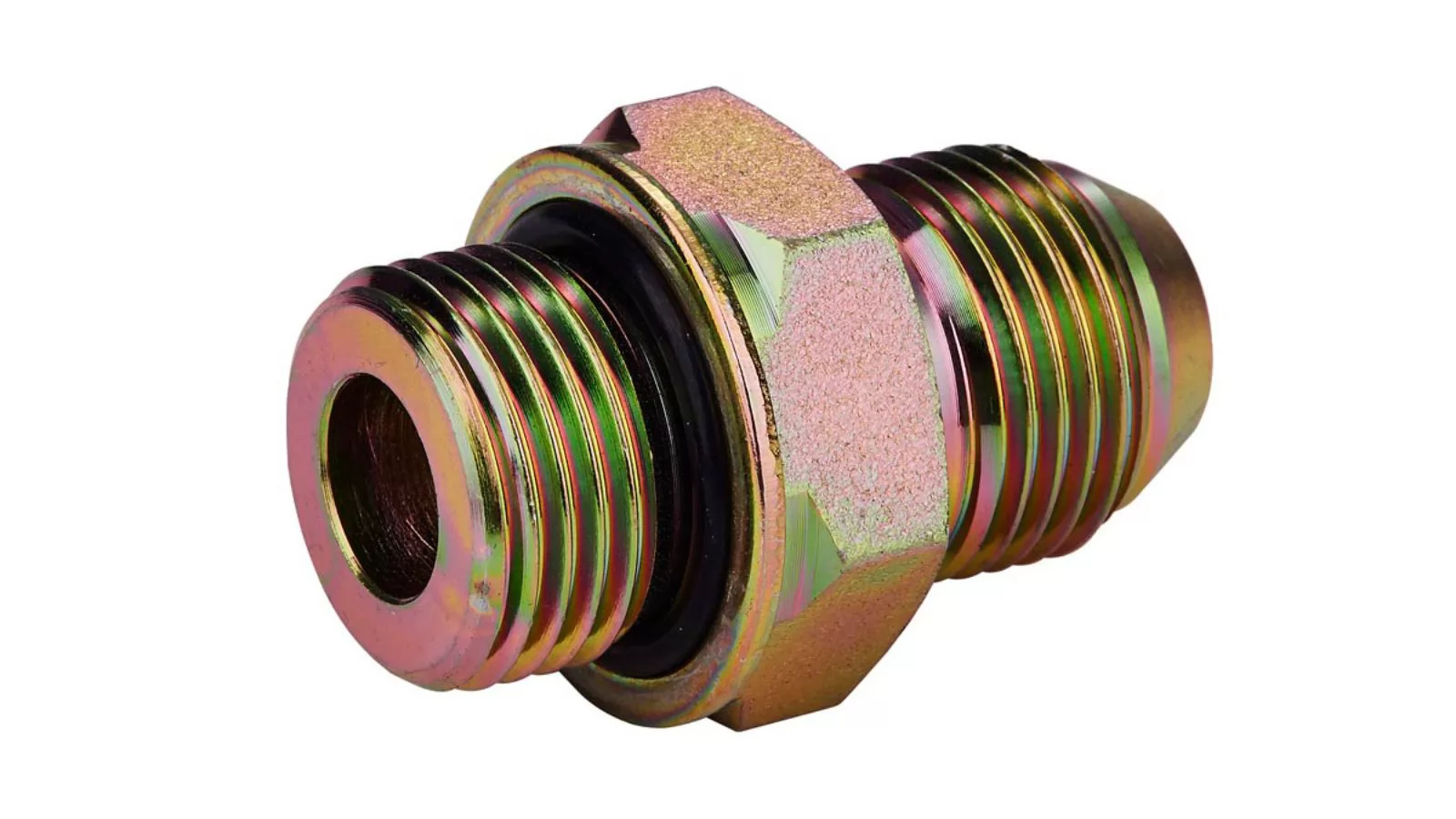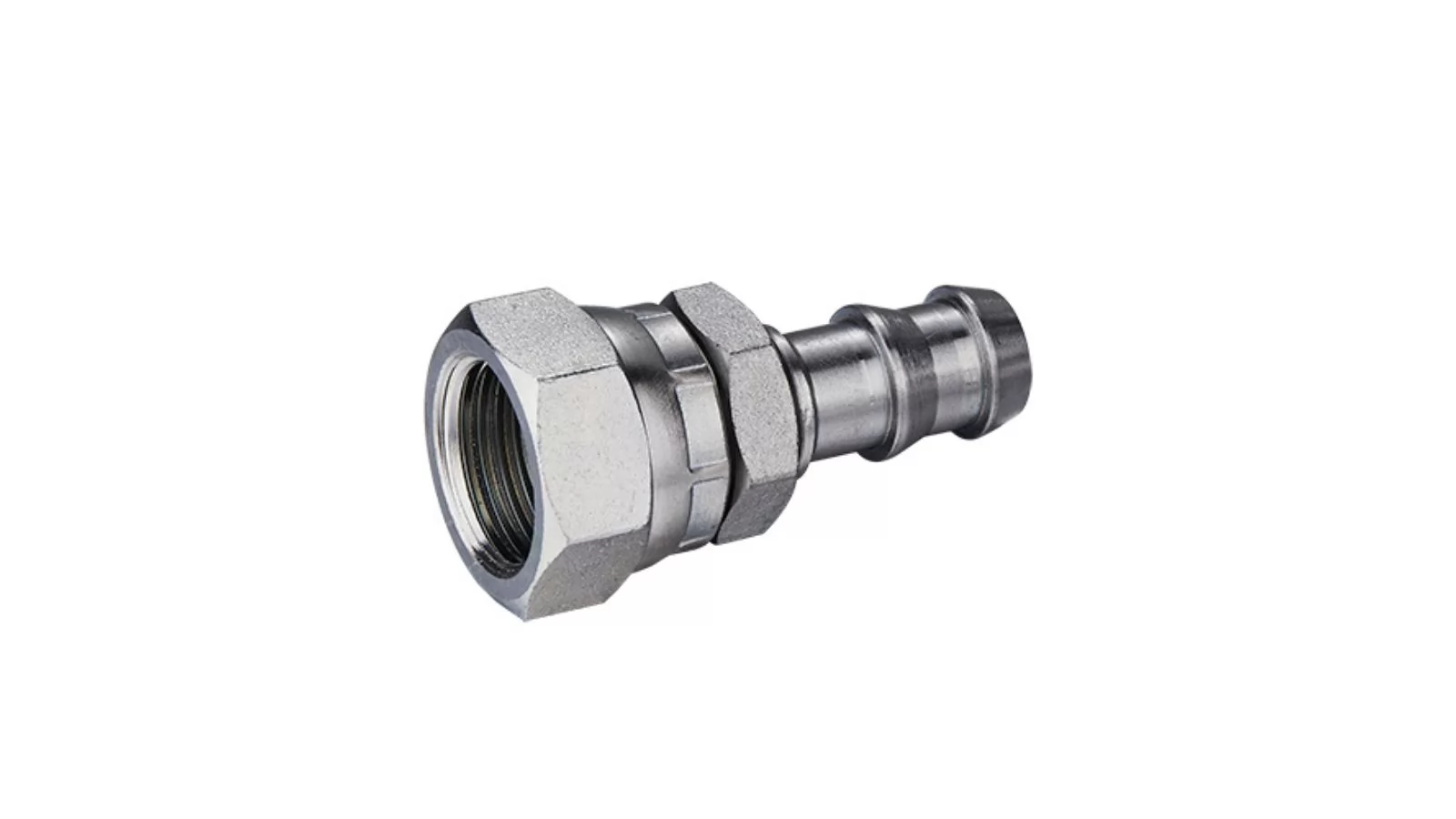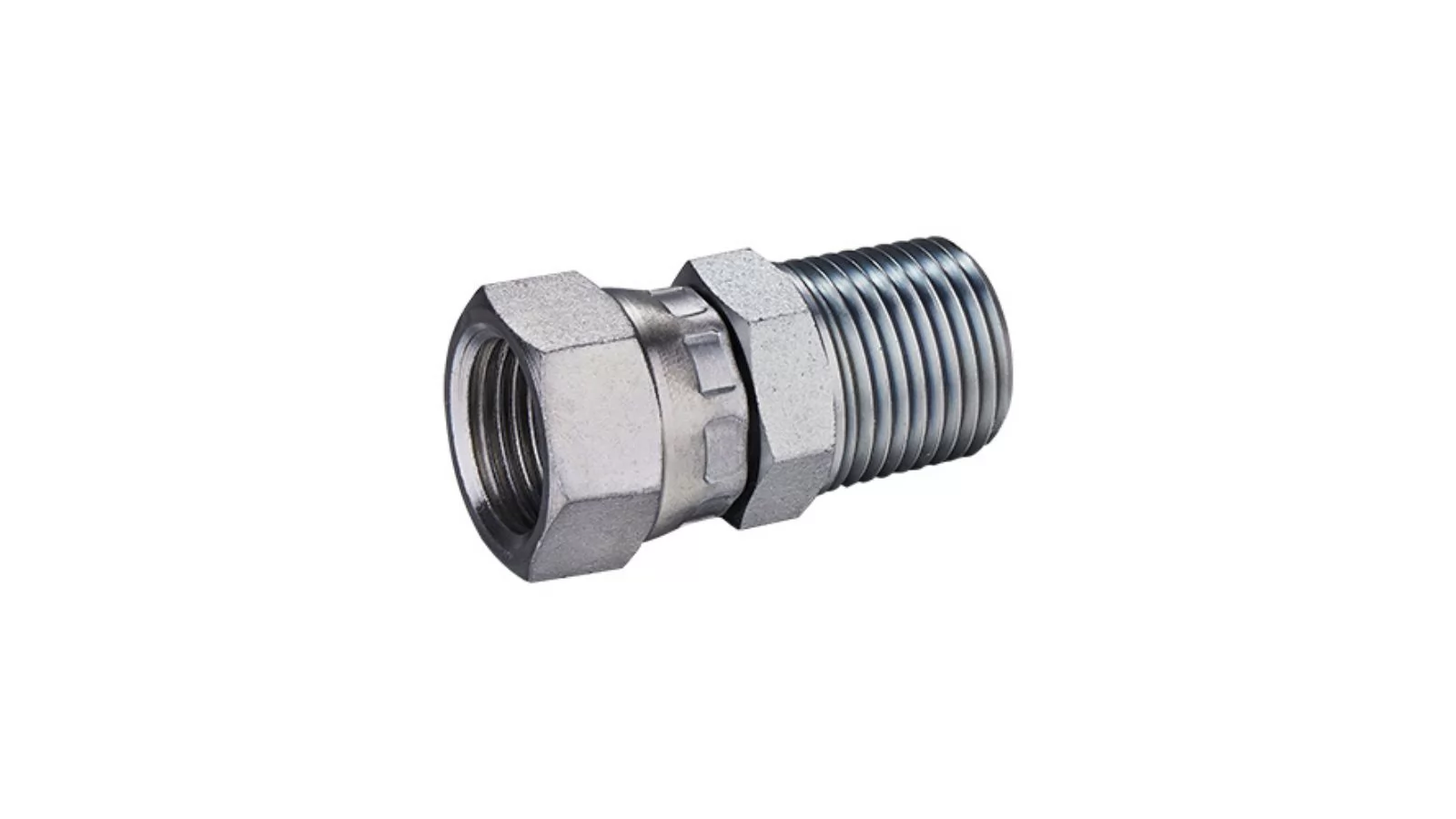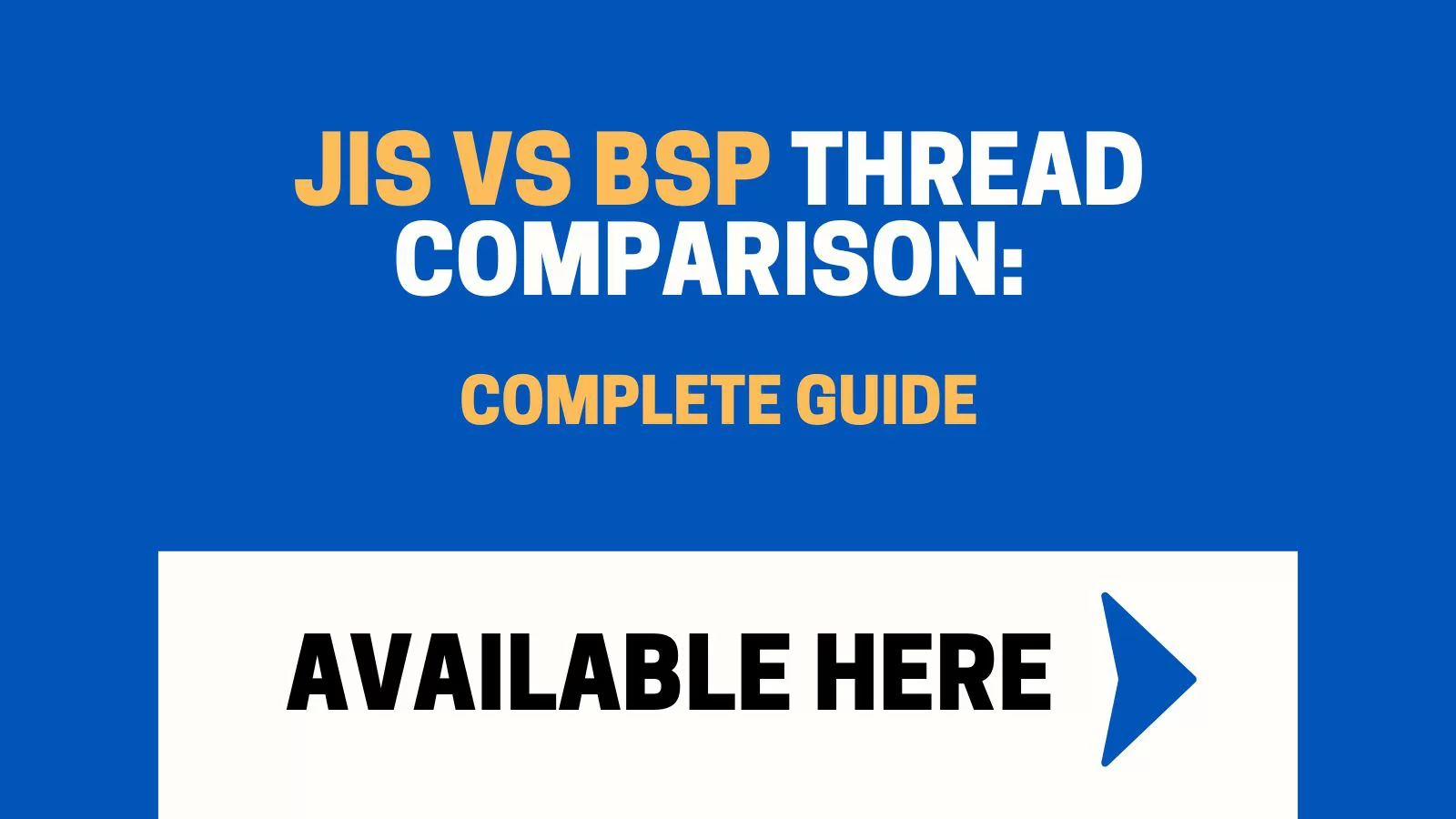JIS vs BSP Thread Comparison: Complete Guide
Table of Content
- Introduction to Thread Standards
- Are JIS and BSP the Same?
- What is a JIS Thread?
- What Does JIS Stand For?
- Is BSP and G Thread Compatible?
- Is BSP Thread Compatible with NPT?
- Is BSP Thread Straight or Tapered?
- What Does BSP Mean?
- Do BSP Fittings Need Thread Tape?
- Do BSP Threads Need Sealant?
- Is NPT Tapered or Parallel?
- Is ISO Thread the Same as BSP?
- What is the Alternative for BSP Thread?
- What is Another Name for BSP Thread?
- How to Make a 1 BSP Thread Watertight?
- Conclusion
- FAQ Section
Introduction to Thread Standards

Thread standards play a critical role in ensuring compatibility, safety, and efficiency across a wide range of mechanical and plumbing applications. A thread standard defines the specific dimensions, angles, and tolerances for screw threads, allowing different manufacturers and industries to produce interchangeable components. Without standardized threads, parts made by different companies could not be reliably connected, leading to potential leaks, mechanical failures, and costly downtime.
Among the many thread standards used globally, the JIS (Japanese Industrial Standard) and BSP (British Standard Pipe) threads are two prominent examples. Each standard is rooted in a different set of historical, industrial, and geographical needs, leading to distinctive characteristics and applications. JIS threads are widely utilized in Japanese manufacturing and industries, whereas BSP threads are predominantly found in European and international plumbing and hydraulic systems.
Understanding the differences and appropriate applications of these thread standards is essential for engineers, technicians, and procurement specialists who work with threaded connections across diverse industries. This guide offers a comprehensive comparison between JIS and BSP threads, helping you make informed decisions for your projects and ensure optimal performance and compatibility.
Are JIS and BSP the Same?
Although JIS and BSP threads may appear similar at first glance, they are distinct thread standards with important differences. JIS, which stands for Japanese Industrial Standard, is primarily used in Japan and industries influenced by Japanese manufacturing. It encompasses a variety of thread types, including parallel and tapered threads, specifically designed to meet Japanese engineering practices and metric measurements.
On the other hand, BSP, or British Standard Pipe, is a thread standard originating from Britain. It is extensively used in Europe, Australia, and many other parts of the world, particularly for plumbing and hydraulic connections. BSP threads come in two main types: BSPP (British Standard Pipe Parallel) and BSPT (British Standard Pipe Tapered), catering to both straight and sealing thread requirements.
Key differences between JIS and BSP threads include thread angle, pitch, and sealing methods. While both standards may use similar profiles (often a 55-degree thread angle for BSP and specific types of JIS threads), their design tolerances, thread forms, and usage conventions differ. As a result, JIS and BSP threads are generally not interchangeable without adapters or specialized fittings, and using them incorrectly can lead to leakage or mechanical failure.
What is a JIS Thread?

JIS threads refer to the standardized screw thread profiles defined by the Japanese Industrial Standards (JIS) organization. Established to harmonize industrial production and ensure consistency in manufacturing, JIS threads are widely used across Japanese industries, including automotive, hydraulic, and pneumatic systems. The most commonly encountered JIS thread types include JIS BSP (similar to BSP but with specific JIS adjustments) and JIS metric threads.
The origin of JIS threads dates back to the post-World War II era, when Japan sought to rebuild its manufacturing sector with strict quality control and standardization. By adopting and adapting various international standards into their own system, Japan developed the JIS standards to support its industrial growth and global competitiveness.
Applications of JIS threads are diverse and typically found in:
- Hydraulic and pneumatic equipment
- Automotive components
- Marine hardware
- Heavy machinery
Technical specifications for JIS threads often include parallel thread profiles with a 30-degree flare at the sealing surface for hydraulic fittings. This design ensures reliable leak-free connections without the need for thread sealant. Although some JIS threads resemble BSP or ISO threads, careful measurement and verification are necessary to avoid mismatched connections.
What Does JIS Stand For?
JIS stands for Japanese Industrial Standards. It is a comprehensive system of standards used in Japan to ensure the quality, safety, and interchangeability of industrial products and practices. Managed by the Japanese Industrial Standards Committee (JISC) and published by the Japanese Standards Association (JSA), JIS covers a wide range of industries, including mechanical engineering, electronics, automotive manufacturing, and construction.
The significance of JIS lies in its role in promoting consistency and reliability within Japanese manufacturing and in products exported around the world. Many components that conform to JIS standards are recognized internationally for their precision and quality.
In the context of threading, JIS threads often follow international thread forms such as BSP or metric designs but incorporate unique specifications tailored for Japanese industrial needs. As a result, JIS threaded components are common in Japanese machinery, vehicles, and equipment, and understanding their specifications is crucial for ensuring compatibility in maintenance, repair, and international trade.
Is BSP and G Thread Compatible?

Yes, BSP and G threads are generally considered compatible, but with important nuances. In technical terms, a G thread refers to a BSPP (British Standard Pipe Parallel) thread, as defined by ISO 228. G threads are parallel threads designed for mechanical joining without the need for a pressure-tight seal on the threads themselves. Instead, sealing is usually achieved through an O-ring, gasket, or washer placed at the face or shoulder of the fitting.
BSP threads, as a broader category, include both BSPP (parallel) and BSPT (tapered) threads. BSPP and G threads share the same thread profile (55-degree angle) and pitch dimensions, making them mechanically compatible when used together. However, G threads are strictly parallel, while BSPT threads are tapered and are not directly compatible with G threads without special adapters or seals.
When matching BSP and G threads, it is critical to:
- Verify whether the BSP thread is parallel (BSPP) or tapered (BSPT).
- Ensure proper sealing methods are used — typically a bonded seal, O-ring, or gasket for G threads.
- Avoid trying to force a tapered BSPT male fitting into a G female thread, as it can cause thread damage and leaks.
Proper identification and matching of the correct thread types are essential to ensure leak-free and durable connections in plumbing, hydraulic, and pneumatic systems.
Is BSP Thread Compatible with NPT?
No, BSP and NPT threads are not inherently compatible due to significant differences in their design and specifications. BSP (British Standard Pipe) threads have a 55-degree thread angle, while NPT (National Pipe Thread), which is a standard mainly used in the United States, has a 60-degree thread angle. This variation in thread form results in mismatched profiles when attempting to join BSP and NPT fittings, leading to poor engagement and potential leakage.
Additional differences include:
- Thread Pitch: BSP and NPT threads often have different thread counts per inch (TPI), which means the threads will not align properly.
- Sealing Method: NPT threads achieve sealing through thread deformation (interference fit), whereas BSP threads (particularly BSPP) typically require a sealing washer or O-ring to create a pressure-tight seal.
- Form: BSP threads can be either parallel (BSPP) or tapered (BSPT), whereas NPT threads are always tapered for sealing purposes.
Guidelines for using BSP and NPT fittings together:
- Use appropriate adapters designed to convert BSP to NPT or vice versa.
- Avoid forcing mismatched threads together as this can damage the fittings and create dangerous leaks.
- Always verify thread type specifications before attempting to connect different standards.
Mixing BSP and NPT threads without the correct adapters or transition fittings is generally not recommended and can lead to system failure, especially in high-pressure applications.
Is BSP Thread Straight or Tapered?
BSP threads can be either straight (parallel) or tapered, depending on the specific type. The two main forms of BSP threads are:
- BSPP (British Standard Pipe Parallel): These threads are straight and maintain a constant diameter throughout their length. BSPP threads typically require a sealing mechanism such as a bonded washer, O-ring, or gasket placed at the face of the fitting to ensure a leak-proof connection.
- BSPT (British Standard Pipe Tapered): These threads are tapered, meaning the thread diameter increases along the length. BSPT threads are designed to form a pressure-tight seal through the deformation and interference of the threads when tightened.
Understanding the differences between BSPP and BSPT is critical because:
- Connecting a BSPT male thread into a BSPP female thread (or vice versa) without proper adapters or sealing solutions can cause mechanical damage and leaks.
- BSPP fittings often rely on an additional face seal, while BSPT fittings generally achieve sealing through thread interference alone.
- In hydraulic, pneumatic, and plumbing systems, choosing the correct thread form ensures reliability and safety under pressure.
When identifying BSP threads, it is important to measure the outside diameter and check whether the thread is parallel or tapered. Tools such as thread gauges and calipers are useful for accurate identification and preventing mismatches.
What Does BSP Mean?

BSP stands for British Standard Pipe. It is a family of standard screw thread types used internationally to connect and seal pipe ends in hydraulic and plumbing systems. BSP threads are recognized for their reliability and widespread adoption in Europe, Asia, and many other regions outside North America.
The BSP standard encompasses two primary thread types:
- BSPP (British Standard Pipe Parallel): Features straight threads that do not taper. Sealing is typically achieved using an O-ring, bonded washer, or gasket placed at the mating surface.
- BSPT (British Standard Pipe Tapered): Features threads that taper along their length, enabling a seal to form through the mechanical interference of the threads themselves when tightened.
Key characteristics of BSP threads include:
- A thread angle of 55 degrees, differing from the 60-degree angle used in NPT threads.
- Measurement units based on the nominal bore (internal diameter) of the pipe, rather than the outside diameter of the thread.
- Commonly used sizes ranging from 1/8 inch to 6 inches, covering a wide array of industrial and commercial applications.
Understanding whether a fitting is BSPP or BSPT is crucial for selecting the correct type of seal and ensuring a leak-free connection. Mismatched thread types can result in assembly difficulties, leaks, or mechanical failure under pressure.
Do BSP Fittings Need Thread Tape?
Whether BSP fittings require thread tape depends largely on the type of BSP thread and the specific application. Generally, the need for thread tape is associated with sealing methods rather than mechanical strength alone.
Key considerations include:
- BSPT (Tapered Threads): For BSPT fittings, thread tape — typically PTFE (Polytetrafluoroethylene) tape — is often recommended. Since BSPT threads are tapered and designed to seal by thread interference, applying thread tape helps fill any small gaps, enhancing the seal and reducing the likelihood of leaks.
- BSPP (Parallel Threads): BSPP threads do not seal on the threads themselves. Instead, sealing is achieved with an O-ring, bonded washer, or gasket at the mating surface. In these cases, applying thread tape is generally unnecessary and can even interfere with achieving a proper face seal.
When using thread tape with BSPT fittings, best practices include:
- Wrap the tape in the direction of the thread turn to prevent it from unraveling during tightening.
- Use 2 to 3 full wraps around the male threads, covering the threads evenly without excessive buildup.
- Ensure the first thread or two remains tape-free to allow easier starting and proper thread engagement.
Choosing whether or not to use thread tape correctly can significantly affect the performance and longevity of the piping system, especially under pressure or in critical applications.
Do BSP Threads Need Sealant?
Yes, in many cases, BSP threads require a sealant to ensure a leak-free connection, but the need for sealant depends on whether the thread is parallel (BSPP) or tapered (BSPT) and the sealing method used.
For different types of BSP threads:
- BSPT (Tapered Threads): BSPT threads typically require a thread sealant such as PTFE tape or a liquid thread sealant. Since BSPT threads seal by the mechanical wedging of the threads, applying a sealant helps fill microscopic gaps, enhances sealing ability, and prevents leaks, especially under pressure.
- BSPP (Parallel Threads): BSPP threads do not rely on thread deformation for sealing. Instead, they usually employ a mechanical seal using a bonded washer, O-ring, or gasket. In this case, sealant on the threads is generally unnecessary and may even interfere with proper face sealing.
Common types of sealants for BSP threads include:
- PTFE Tape: Commonly used for BSPT threads; it is easy to apply and provides a good basic level of sealing.
- Liquid Thread Sealants: Such as anaerobic sealants, which cure in the absence of air to form a strong, leak-proof bond. These are often used in high-pressure or vibration-prone environments.
- Sealing Washers: For BSPP threads, bonded or flat washers provide the necessary seal at the face of the fitting.
Applying the correct type of sealant is crucial to ensure long-term durability, avoid leaks, and maintain the integrity of the system, especially in hydraulic, pneumatic, and fluid transfer applications.
Is NPT Tapered or Parallel?

NPT (National Pipe Thread) is a tapered thread, not a parallel one. The tapering of the thread is a defining feature of the NPT standard, which is primarily used in North America for piping and plumbing systems.
Key characteristics of NPT threads include:
- Tapered Profile: The diameter of NPT threads decreases along the length of the male thread and increases along the length of the female thread. The standard taper rate is 1/16 inch per inch of thread length (approximately 1.79 degrees).
- Sealing Mechanism: NPT threads create a seal by the wedging action that occurs as the male and female threads are tightened together. This mechanical interference forms a pressure-tight seal, often enhanced by the application of thread sealant or PTFE tape.
- Thread Angle: NPT threads have a 60-degree thread angle, different from the 55-degree angle used in BSP threads.
When choosing between NPT and BSP threads, it is important to remember:
- NPT threads are always tapered and rely heavily on thread engagement for sealing.
- BSP threads can be either parallel (BSPP) or tapered (BSPT), and their sealing methods vary accordingly.
- Mixing NPT and BSP threads without proper adapters is not recommended due to differences in thread design and sealing behavior.
Proper identification and correct matching of thread types are essential for ensuring a secure, leak-free connection, particularly in high-pressure or safety-critical applications.
Is ISO Thread the Same as BSP?
No, ISO threads and BSP threads are not the same, although they can sometimes appear similar and are used in overlapping applications. ISO threads refer to thread profiles standardized by the International Organization for Standardization (ISO), and they encompass a broader range of thread types, including ISO metric threads and ISO pipe threads.
Key differences between ISO and BSP threads include:
- Thread Type: ISO threads typically refer to ISO metric threads (used for bolts, screws, and mechanical fasteners) or ISO 228 threads (parallel pipe threads). BSP threads are specifically intended for pipe connections and sealing in plumbing and hydraulic systems.
- Thread Angle: Both BSP and ISO 228 pipe threads use a 55-degree thread angle, but ISO metric threads use a 60-degree angle, like NPT threads.
- Application: BSP threads are mainly used for fluid and gas transportation applications, whereas ISO metric threads are widely used for fastening and mechanical assemblies.
Similarities and distinctions in usage:
- ISO 228 (parallel pipe threads) are very similar to BSPP (British Standard Pipe Parallel) threads and are sometimes considered interchangeable for non-sealing applications.
- However, care must be taken to ensure that sealing methods and thread tolerances match the specific system requirements.
When to choose ISO over BSP:
- For international manufacturing where ISO standards are the norm.
- When dealing with metric-based mechanical systems rather than plumbing or piping systems.
- When required by specifications for standardization or compliance reasons in global markets.
Proper understanding of the application and thread standard is vital to avoid compatibility issues, leaks, and mechanical failures when working with ISO and BSP threaded components.
What is the Alternative for BSP Thread?
Several alternatives to BSP threads exist, each suited for different regional standards, industries, and application requirements. The most common alternatives include NPT (National Pipe Thread), JIS (Japanese Industrial Standard) threads, and ISO threads.
Overview of other thread standards:
- NPT (National Pipe Thread): Predominantly used in North America, NPT threads are tapered and seal through thread interference. They differ from BSP threads in both thread angle (60 degrees for NPT vs. 55 degrees for BSP) and thread form, making them incompatible without adapters.
- JIS Threads: Used mainly in Japan and industries influenced by Japanese manufacturing. JIS threads include types similar to BSP (JIS BSP) but with slight dimensional and tolerance differences. They are common in hydraulic and pneumatic systems.
- ISO Threads: ISO metric threads are widely used for mechanical fastening, while ISO 228 threads (parallel pipe threads) can serve as alternatives for BSPP threads in certain non-sealing applications. However, sealing methods may differ.
Comparison and recommendations:
- For hydraulic and pneumatic systems: JIS threads are often a suitable alternative due to their reliability and similarity to BSP profiles.
- For plumbing systems in North America: NPT threads are the standard and preferred choice.
- For global manufacturing or metric systems: ISO threads provide broad international compatibility and are ideal for projects requiring compliance with worldwide standards.
When considering an alternative to BSP threads, it is essential to evaluate the pressure requirements, sealing methods, thread compatibility, and regulatory standards to ensure optimal performance and safety.
What is Another Name for BSP Thread?
BSP threads are often referred to by several alternative names, depending on the region, industry, and specific application. Understanding these variations helps in correctly identifying fittings and components during international procurement or technical discussions.
Common alternative names for BSP threads include:
- British Standard Pipe Thread: This is the full formal name for BSP, often used in official documentation and engineering specifications.
- G Thread: A G thread refers specifically to the BSPP (parallel) variant of BSP threads as defined by ISO 228. In some industries, especially plumbing and hydraulics, BSPP threads are simply called G threads.
- Gas Thread: In some European countries, BSP threads are colloquially referred to as "Gas threads" because they were historically used in gas piping systems. This term typically refers to BSPP threads.
- R Thread: The R designation is often used for BSPT (tapered) threads, according to ISO 7-1. For example, an "R 1/2" thread would be a 1/2 inch BSPT thread.
Regional variations and terminology:
- In Germany and parts of Europe, BSPP threads are often labeled with the letter "G" (e.g., G1/2), while BSPT threads are labeled with "R" (e.g., R1/2).
- In British and Commonwealth countries, simply saying "BSP thread" is usually sufficient, but the distinction between parallel (BSPP) and tapered (BSPT) may still be important in technical contexts.
Being aware of these alternate names and designations ensures correct selection, ordering, and installation of components, particularly in international or multi-standard environments.
How to Make a 1 BSP Thread Watertight?
Achieving a watertight seal on a 1 BSP thread requires careful preparation, proper sealing techniques, and the correct choice of materials. The method slightly varies depending on whether the thread is BSPP (parallel) or BSPT (tapered).
Here is a step-by-step guide:
-
Identify the Thread Type:
- If it is a BSPP (parallel) thread, sealing will occur at the face using a bonded washer, O-ring, or gasket.
- If it is a BSPT (tapered) thread, sealing will occur on the thread surfaces themselves, typically requiring thread sealant.
-
Clean the Threads:
Ensure both male and female threads are clean, free of dirt, oil, and old sealant. Use a wire brush or cloth if necessary.
-
Apply the Correct Sealant:
- For BSPT threads, wrap PTFE tape around the male threads. Wrap in the direction of the threads (clockwise when facing the fitting end) 2-3 times, covering the threads evenly but avoiding excess buildup.
- Alternatively, a liquid thread sealant can be used for BSPT threads for high-pressure or critical applications.
- For BSPP threads, do not apply tape to the threads. Instead, use a bonded sealing washer or O-ring between the mating faces.
-
Assemble the Fittings:
Hand-tighten the fitting first, then use a wrench to tighten further. Be careful not to over-tighten, as this can deform the threads or sealing washer and cause leaks.
-
Test for Leaks:
Once assembled, pressure test the system. If minor leaks are detected, slightly tighten the fitting. If leaks persist, disassemble, reapply sealant, and reassemble.
Common mistakes to avoid:
- Using thread tape on BSPP threads where sealing occurs at the face rather than on the threads.
- Over-tightening fittings, which can damage threads or sealing elements.
- Applying too much or too little thread sealant, leading to improper sealing or contamination of the system.
By carefully following these steps, you can ensure a reliable, watertight seal on a 1 BSP thread connection, whether used in plumbing, hydraulic, or pneumatic applications.
Conclusion
Understanding the differences and proper usage of JIS and BSP threads is crucial for ensuring the reliability, safety, and efficiency of mechanical and plumbing systems. While JIS threads are standardized for Japanese industries and often resemble BSP profiles, they have unique specifications that require careful attention during selection and installation. BSP threads, with their division into BSPP (parallel) and BSPT (tapered) types, offer flexibility but demand the correct sealing methods to ensure leak-free performance.
Key points to remember include:
- JIS and BSP threads are not directly interchangeable without verification and potential adaptation.
- BSPP threads require face sealing, while BSPT threads seal through thread interference, often aided by thread sealant.
- Compatibility between thread types such as BSP, NPT, and ISO should be carefully assessed to avoid mechanical failures and leaks.
Choosing the right thread standard for your specific application involves understanding not only the thread profiles but also the system pressure requirements, regional standards, and appropriate sealing techniques. A well-informed selection leads to improved performance, reduced maintenance costs, and enhanced operational safety across industries.
FAQ Section
Are JIS threads compatible with BSP threads?
While JIS threads and BSP threads can appear similar, they are not fully compatible without careful verification. JIS threads often follow BSP-like profiles but with distinct dimensional and tolerance differences. Using JIS and BSP components together without proper adapters may result in leaks or mechanical failure.
Can BSP and NPT threads be connected directly?
No, BSP and NPT threads should not be connected directly. Their thread angles, pitch, and sealing mechanisms differ, making them incompatible. Special adapters must be used if a transition between BSP and NPT threads is necessary.
How can I identify if a BSP thread is parallel or tapered?
You can measure the diameter along the thread length:
- If the diameter remains consistent, it is a BSPP (parallel) thread.
- If the diameter gradually increases or decreases, it is a BSPT (tapered) thread.
Using a caliper and a thread pitch gauge helps ensure accurate identification.
Is PTFE tape always required for BSP threads?
PTFE tape is commonly used for BSPT (tapered) threads to improve the seal. However, for BSPP (parallel) threads, sealing usually occurs at the mating face using a washer or O-ring, and thread tape is generally not required.
What is the safest method to seal BSPP fittings?
The safest method for sealing BSPP fittings is to use a bonded sealing washer, gasket, or O-ring placed at the mating surface. This ensures a reliable, pressure-tight connection without relying on thread deformation.
Are ISO 228 threads interchangeable with BSPP threads?
ISO 228 threads and BSPP threads are very similar and are often interchangeable in non-pressure sealing applications. However, sealing methods must be appropriate to the application, as ISO 228 specifies non-pressure tight threads unless additional sealing measures are used.
Where are BSP threads most commonly used?
BSP threads are widely used in plumbing, hydraulic systems, and pneumatic applications across Europe, Asia, Australia, and many international markets outside of North America.
What should I do if I accidentally mix thread types?
If different thread types are accidentally mixed, do not force the connection. Identify the correct thread standards and use the proper adapters or fittings designed for cross-standard transitions to avoid leaks and equipment damage.
Where can I find more resources on thread standards?
For further detailed information, consider consulting the official standards documents such as ISO 228, ISO 7-1, and JIS B 0203. Industry-specific handbooks, manufacturer guides, and technical standards organizations like the British Standards Institution (BSI) and Japanese Industrial Standards Committee (JISC) are also excellent resources.
-
2025 Shanghai Bauma Exhibition China International Construction Machinery ExhibitionUpdate on 2024-12-25
-
2025 Las Vegas International Mining ExhibitionUpdate on 2024-12-25
-
Leading the High-End and Empowering the World | Bauma China 2025, Hgw Successfully ConcludedUpdate on 2024-12-25
-
Hgw's Multi-field Hydraulic Products Appeared at the Exhibition丨MINEXPOUpdate on 2024-12-25
-
2025 PTC ASIAUpdate on 2025-02-12
-
Top 10 Leading Hydraulic Fitting Companies in the World[2025 Updated]Update on 2025-02-27
-
Top 10 Global Suppliers of Hydraulic Hose FittingsUpdate on 2025-03-04
-
HGW's O-Ring Face Seal Fittings(ORFS): From Core to Best UseUpdate on 2025-03-08
















